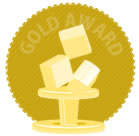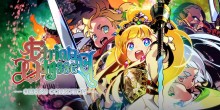Etrian Odyssey Origins Collection (Nintendo Switch) Review
By Renan Fontes  18.06.2023
18.06.2023

Etrian Odyssey's legacy is intimately tied to the Nintendo DS' dual screens, so much so that most audiences wrote off the idea that Atlus would ever re-release the series for modern hardware. The act of physically mapping out the touch screen and treating the bottom screen as a proper map is an important part of the franchise's gameplay loop, but it doesn't necessarily require two screens. Case in point: Etrian Odyssey Origins Collection. The first three Etrian Odysseys have been lovingly remastered for modern consoles, with their Nintendo Switch port arguably the best of the bunch thanks to its touch screen. Even then, the inclusion of quality-of-life features like auto-mapping eliminate the need for touch controls entirely while placing a greater emphasis on Etrian Odyssey's fantastic dungeon design and life-or-death battles.
Despite an often-hostile difficulty curve, Etrian Odyssey is a comfortable series, to the point where each entry more or less follows the same structure. Players are tasked with forming a part of at least five adventures and exploring a multi-floor dungeon called Yggdrasil that only gets denser and more dangerous the deeper in they go. The gameplay loop mixes the hardcore dungeon-crawling that defined most RPGs in the 80s & 90s with light resource management where an inventory cap forces players to regularly take breaks from dungeoneering to sell their items, buy new gear, take on new quests, or vary up their party against new challenges. This uniformity isn't a flaw, however, but a feature. Etrian Odyssey is a series that does not fix what isn't broken, instead refining and maintaining what works across each entry - a design philosophy that shines bright when playing all three entries in the Etrian Odyssey Origins Collection back to back to back.
Perhaps the first thing worth noting is that Etrian Odyssey Origins Collection collects only the original versions of the first three titles. The first two installments notably had 3DS remakes under the Etrian Odyssey Untold moniker which added an in-depth story mode, voice acting, and quality of life changes to their base games. Etrian Odyssey proper is very light on narrative, to the point where it can be written off as mere set dressing for most titles, so RPG fans should temper their expectations accordingly. That said, the first two entries aren't that much worse for wear for not having their Untold content. If anything, the series' emphasis on gameplay over plot is one of its main appeals, so it makes more sense for the Origins Collection to present Etrian Odyssey I and II in their original forms. III has more story than its predecessors, but even it keeps the focus on gameplay first and foremost. Just as importantly, preserving the DS originals keeps the experience consistent across the trilogy as The Drowned City was never remade.
In spite of similarities between all three titles, every Etrian Odyssey has a distinct "flavor" so to speak that allows each installment to cultivate a unique identity while keeping the franchise's core gameplay loop perfectly intact. Etrian Odyssey I embraces an old school fantasy vibe and traditional RPG environments (albeit not without its own sense of personality or twists). Etrian Odyssey II flips the script so players now climb Yggdrasil instead of descending deeper into the dungeon, embracing a more "divine" aesthetic. Etrian Odyssey III is mostly nautically & tropically themed and even introduces a sailing mechanic to round out the gameplay loop (on top of new features fitting the series' final entry on the DS before Etrian Odyssey IV's 3DS release). Anyone who knows they want to experience the whole series should start with I and make their way through linearly (II even lets players transfer their data from I over). Players who just want a taste and don't want to necessarily play the whole trilogy will miss nothing by just starting with III.

Gameplay-wise, party composition is very important across the entire collection. Although parties can only be composed of five characters, 30 different party members can be registered to each entry's Guild. With 9 classes available in the first entry along with a dozen in the second and third respectively, players are afforded a generous amount of freedom in building their party. Players are free to double up on classes, run multiple parties, or build a party with less than five members for more experience from battles. Players can slot party members into either the front or back row, with melee fighters benefitting from fighting on the frontlines and support/utility characters better suited for the backline. Each class is distinct with access to their own set of weapons, armor, and skill trees that can be used to develop party members to their full potential. Etrian Odyssey's party system encourages experimentation and rewards players who take the time to learn the nuances behind every class.
Registering a new hero is as simple as going to the guild and creating them. Upon picking a class, players can rename their new hero and select their appearance based on five different portraits. The real meat behind character building comes through the skill tree system. No character can learn every single skill in their tree, demanding players pick and choose which abilities to not only learn, but actively develop. Characters only earn 1 skill point upon leveling up and there aren't enough to go around. It's important to pick which skills to level carefully, keeping in mind not only what each individual character is capable of but how they synergize with the rest of the party. Randomly leveling skills is one of the fastest ways to build an ineffective party. Part of the fun is also figuring out how to get classes and skills to work together at full potential, actively encouraging players to think about their party customisation on a deeper level.
Etrian Odyssey's gameplay loop has a specific rhythm that balances dungeon-crawling with resource management. Enemies drop items that must be sold at shops to unlock more purchasable equipment. The inclusion of a hard inventory limit more or less forces players to go back to town regularly and sell your wares. More importantly, going back to town offers players an opportunity to rest, save their game, rearrange their party, or simply take on new side quests. Yggdrasil is a long dungeon broken down into Stratums divided into floors, making it impossible to clear in one go. Jumping back to town every so often also offers some necessary breathing room given how demanding later floors often are. Periodic respites keep players from feeling bogged down by non-stop dungeon-crawling white letting them make real progress outside of battle, either by unlocking new items at the shops or clearing out quests.

Yggdrasil might be one single dungeon, but it hardly feels like it. Each Stratum has a distinct visual style that helps differentiate it from the rest of the dungeon and across games. Don't expect to see the same biomes between titles and environments only become radical from Stratum to Stratum. Floors maintain a consistent visual style within their Stratums, but their actual level design is almost always unique, giving each floor its own feel or specific challenges. Early floors are usually made up of mainly branching paths, dead-ends, shortcuts, and lots of treasure to find. The deeper players get into a Stratum, the more aggressive enemies and the floors become. Traps, damage tiles, and stalker enemies (called FOEs) roam around and trigger battle when they run into the party. Avoiding them is often framed like a puzzle (as seen in the case of the Wyvern Egg quest in Etrian Odyssey I). The level design embraces an old-school hostility that's just not seen in most RPGs anymore. Individual floors tend to be quite long and later ones often require multiple trips to reach the end of, let alone fully map out.
Mapping is a staple of Etrian Odyssey's gameplay loop and one of the main reasons some fans felt the series would never leave the confines of the Nintendo DS or 3DS. Players need to map out each floor themselves, which was previously done by drawing on the touchpad with the DS stylus. Although players can still physically draw their map by using the Switch's touchscreen while undocked, manual button mapping and auto-mapping have been introduced to make everyone's lives easier on home consoles. Button mapping isn't as fluid as touch drawing, but the controls work surprisingly well. Right-stick moves around the mini-map map, ZR & ZL select icons and place them, and the X button turns the map into a mini-map, allowing players to take in the scenery.
There are some drawbacks to losing dual screens - the mini-map either eats up half the screen or is so small, it's useless - but nothing is a big enough deal breaker to ruin the experience, especially since the in-game visuals are so crisp. Newcomers likely won't even be put off by mapping without a stylus, but used to the original DS releases will be in for an adjustment. It's fun playing cartographer, leaving memos for later, and marking opened chests, shortcuts, or harvesting points. A fully mapped out room is easier to navigate than just running blind through each floor, which is especially important to consider since players will likely need to revisit floors multiple times to fully clear them. Mapping isn't for everyone, though, which is where auto-mapping comes in. Found in the options, auto-mapping automatically fills in any tile or wall players run into. Special details like treasure chests and staircases are left unmarked, however, meaning that the mechanic only offers players the bare minimum. Even then, that's a huge quality of life improvement for anyone who doesn't care for cartography.
While Etrian Odyssey doesn't have much in the way of conventional storytelling, little moments and impromptu events inside of Yggdrasil help give each adventure plenty of personality. The party can mine, choose down trees, or gather materials; find springs to drink from or random fruit to eat. Every event comes with a choice of interaction, allowing the party to walk away safely or take their chances. Strange fruit can either restore the party leader's health or take damage away. Squirrels can steal Ariadne Threads, the only way of warping back to town safely. Investigating a bush can lead to treasure or a battle. There's always an element of risk involved and a lot of the series' charm is rooted in how it almost plays like a Dungeons & Dragons campaign where a single roll can make or ruin a session.

Aesthetically, a day & night system cycles through Morning, Day, Evening, and Night every few in-game hours. Watching the skyline change helps convey the passage of time and fosters a deeper sense of immersion inside dungeons. The visuals on a whole look incredibly crisp. Environmental details are rich and colourful, and enemy sprites really benefit from the upgrade in resolution. Yuzo Koshiro's soundtrack similarly shines a bit brighter now that it's no longer confined to the DS' speakers. Koshiro's music gives each Stratum a palpable atmosphere while lending battles a tense and energetic energy. Dungeon-crawling is relaxing and battles are intense, something reflected in each entry's score.
Battles themselves can be extremely punishing. A single wrong move can spell doom and even random encounters can feel life or death. Getting a Game Over lets players keep their map progress, but any experience or items gained since the last save are lost. It's important to approach each battle strategically and avoid FOEs the party isn't prepared for. A lot of strategy goes into getting through random encounters quickly and surviving bosses. Smart skill and item usage go a long way, and it helps to build a party that can take advantage of elemental weaknesses, cast buffs or debuffs, and keep everyone healed or status effect-free. It's sometimes smarter to just outright escape. Combined with a relatively high encounter rate, recklessly auto-battling will wear down parties fast.
Each HD remaster gives players the option to choose between three difficulties. Expert is more or less the original DS release's difficulty curve and poses a real challenge from top to bottom. Basic is easier than the original difficulty, but not so much so where it doesn't put up a challenge. This is the best option for newcomers or any would-be fans who found the original DS titles too overwhelming. Picnic is extremely easy to the point where players can easily auto-battle their way through multiple floors safely. Even FOEs can be killed with next to no strategy on Picnic. The mode is good for power-grinding new party members, but isn't particularly fulfilling on a gameplay level.
A massive amount of quality content across each entry gives the Etrian Odyssey Origins Collection enough replay value to last players hundreds of hours. A single playthrough is plenty long as is, but New Game Plus helps give the three games new life. The price point may be on the steeper side for a collection, but given how pricey the DS originals are these days, it's good value for a lot of content. More importantly, Etrian Odyssey Origins Collection makes a once-landlocked series accessible to modern players.

Cubed3 Rating
Exceptional - Gold Award

Etrian Odyssey Origins Collection is a wonderful repackaging of three of the best RPGs on the Nintendo DS, maintaining nearly all the benefits of dual screens while offering players respectable quality-of-life features. What Etrian Odyssey lacks in conventional narrative, the series makes up for with its emphasis on player-driven pacing and highly customisable party building. Although the price point is certainly steep, there's no getting around the fact that these are the definitive versions of the first three Etrian Odysseys. Visually crisp with great audio and some of the best dungeon-crawling the genre has seen, all three titles offer RPG fans hundreds of hours of dense dungeon-crawling all on their own. Together, the collection offers audiences a high-class trilogy that'll realistically last them the rest of 2023 - if not even longer. Etrian Odyssey Origins Collection is frankly a steal at $80.

![]() 9/10
9/10
![]() 0
(0 Votes)
0
(0 Votes)
 Out now
Out now  Out now
Out now  Out now
Out now  Out now
Out now Comments
Comments are currently disabled

 Sign In
Sign In Game Details
Game Details Subscribe to this topic
Subscribe to this topic Features
Features







 Top
Top

